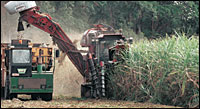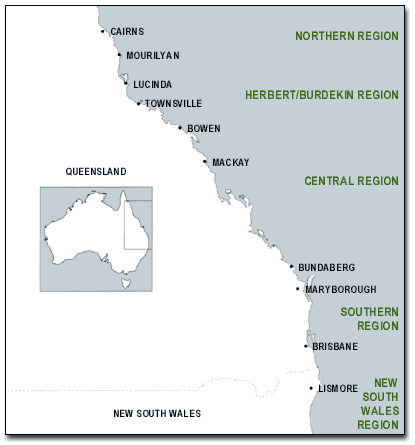As
Australia's second largest export crop and Queensland's largest rural commodity,
sugar is a major contributor to the Australian economy.
Raw
sugar is produced from sugarcane in three of the Australian states,
approximately 94.2 percent in Queensland, 5.1 percent in New South Wales and 0.7
percent in Western Australia. There are currently 26 raw sugar mills in
Queensland (including one mill that processes sugarcane to syrup stage only), 3
in New South Wales and 1 in Western Australia.
Australia
is currently one of the world's largest exporters of raw sugar, with Queensland
exporting about 80 to 85 percent of its total raw sugar production. Almost 100
percent of raw sugar exports originate in Queensland. Total sales of Queensland
raw sugar are around $2 billion annually.
Australia
also exports refined sugar. Currently there are four sugar refineries in
Australia, 2 in Queensland (Mackay & Bundaberg), 1 in New South Wales
(Harwood), and 1 in Victoria (Melbourne).
Most
sugarcane is grown on coastal plains and river valleys along 2100 km of the
eastern coastline between Mossman in Far North Queensland and Grafton in the
northern part of the adjoining State of New South Wales (NSW). A small industry
in the Ord River region of the State of Western Australia had its first full
season in 1996.
Australia
has over 545,000 hectares (ha) devoted to cane growing. Sugarcane area in
Queensland has increased by over 40% since 1988 and now exceeds 508,000 ha cane
fields represent 20% of Queensland's total crop area. Most cane is grown within
80 km of the coast, mainly in high rainfall areas and based on numerous river
systems.
The
sugar industry underpins the economic prosperity of many coastal communities.
Reliable
rainfall (or stored water for irrigation) is vital to productive and profitable
cane growing. Sugarcane accounts for over 40% of water users in Queensland. Some
66% of cane growers have some form of irrigation. Irrigation is essential for
crop growth in the Burdekin and Atherton Tableland districts (and in the Ord in
WA) and is used on a supplementary basis in other cane growing districts.
In
the 1997 season Australia produced 5.74 million tonnes (Mt) of raw sugar from 41
Mt of sugarcane harvested from 419,915 ha. Of this, Queensland producers
accounted for 5.4 Mt of sugar crushed from 38.1 Mt of cane harvested off 397,512
ha. Australia's average cane production was 98 t/ha and sugar production was
13.75 t/ha.
Twenty
mills each crushed over one million tonnes of cane. Mill throughput ranged from
3.81 Mt of cane at Victoria Mill to 402,600 tonnes at Australia's only privately
owned mill at Rocky Point. Nearly 65% of the Queensland crop was harvested without
burning and green harvesting. Queensland sugar mill owners own operate and
maintain 4100 km of narrow gauge (610 mm) railway, over which 94% of total cane
production is transported to 23 mills.
In
1998 the first new sugar mill to be built in Queensland in over 70 years began
crushing cane on the Atherton Tablelands, inland from Cairns. Since 1985, six
Queensland mills have closed - Qunaba (1985), Goondi (1987), North Eton (1988),
Cattle Creek (1989), Hambledon (1991) and Nambour (2003). Cooperative (grower-owned) entities
own 12 of Australia's sugar mills.
Size
of most cane farms are from 30 to 120 hectares. The average Queensland cane farm
in 1997 produced 5840 tonnes of sugarcane. Most are owned and operated by family
farmers. Sugar mill owners produce less than 2.5% of cane output.
In addition,
CANEGROWERS recognises an industry that includes in its product mix ETHANOL
and
other fermentation products will reduce our reliance on the world sugar market
and, potentially, stabilise industry income and reduce industry price risk.
In order to
reduce the industry’s exposure to the world sugar price, CANEGROWERS therefore
adopts as its target that, in the future, a significant proportion of the income
stream from sugarcane growing should come from ethanol and fermentation
products.
In order to
achieve this objective, CANEGROWERS will support:
![]()
![]()







